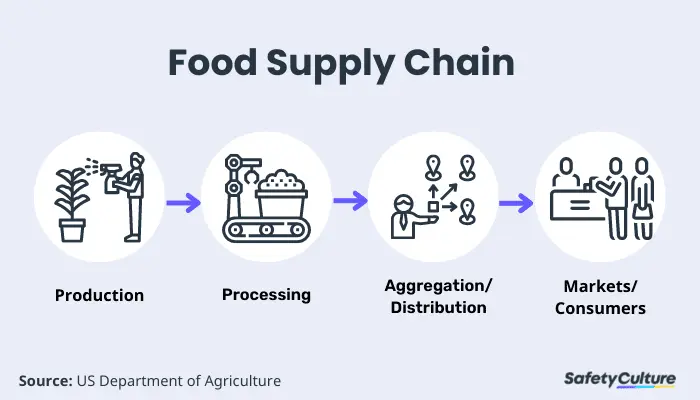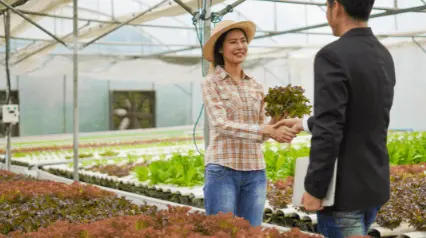What Is the Food Supply Chain?
Food goes through a lot of processes before landing on a person’s table. And all of these processes—from farming, processing and packaging, and down to food delivery— are part of the food supply chain. The food supply chain is a summary of every process involved in producing and delivering food to households and distributors.
Different parts of the food supply chain apply to different industries. For example, for food management and distribution, their supply chain involves the incoming quantity of materials, ways to process raw ingredients, storage, delivery, and more. And for farmers, the supply chain involves sourcing seeds and livestock, harvesting crops and meat, and shipping them to manufacturers and food processors.
Importance
Every human needs to eat. And as technology and food processing practices have evolved, humans have created complex systems to grow, process, and deliver food to people all over the world. But to ensure that as many people get food on their table as possible, each part of the process needs to be traceable.
That’s why the food supply chain holds a lot of significance nowadays. Having a proper chain wherein farmers, food processors, and distributors can trace each process allows for more transparency. So, in the event of a shortage of contamination, the source is easily traceable, and finding solutions is much simpler.
A study by RTS shows that over 1.4 billion tons of food waste are generated every year. While significant chunks of food waste come from homes and restaurants, there’s also a large percentage also stems from the farms and manufacturing plants.
Tackling food waste and ensuring the food goes where it needs to go is why the food supply chain is of the utmost importance. Understanding each step in bringing food to someone’s table can generate a better idea of how to tackle certain problems and ensure that more people gain access to food.
How It Works
There are many areas of the food supply chain. But, the entire chain begins from where farmers get their raw materials. This includes the seeds for crops, their livestock, and the materials they need to farm. From there, the process moves on to farming the crops and raising the livestock before the crops and meat are harvested.
After that, the process shifts over to the food processing side. This is where manufacturers and butchers get the supplies, chop the meat, process the vegetables, and package it. Once packaging is done, the goods are sent out to groceries, restaurants, and other establishments before ending up on people’s tables.
While there are sub-steps and processes in every link in the chain, this is generally how the chain works. But for a more detailed example, you can refer to the image below.
Food Supply Chain Example

In this simplified example, a farmer grows the food and transforms it into a specific ingredient. Then, a manufacturer processes the ingredients and packages them before sending them out to distributors. From there, the distributors sell the food to consumers and restaurants, who ultimately eat and consume the food at the end of the chain.
Disruptions to the Chain
Quite a few occurrences and instances could disrupt the food chain and cause complications down the line. This could lead to people not getting food, prices going up, and more. Here are some common disruptions we may be able to see in the food supply chain:
Health Crisis
The COVID-19 pandemic took the world by storm and caused many people to change how they lived their lives. And with most workers staying home at the start of the pandemic, there weren’t enough employees to work the farms, manufacturing plants, and grocery stores that are crucial to an uninterrupted food supply chain.
Other health crises may have similar effects on the chain. For example, an outbreak at a certain farm could result in food contamination. And before even reaching shelves, the contaminated products may be discarded, resulting in more waste and less food reaching people’s tables.
Extreme Weather Conditions
Another thing that can affect the supply chain is the weather. Storms, blizzards, and other disasters can affect factories, farms, and delivery routes. And when one of these things is damaged, the food output is greatly reduced, which can disrupt the supply chain.
Energy Security
Another concern with the food supply chain is energy security. Every link in the chain relies on energy in one way or another. For example, farmers require a lot of energy to maintain their crops and livestock, while manufacturers usually rely on electricity to process and package food.
On top of that, delivery services need to deliver the food to manufacturers. This means they rely on gasoline to deliver the food to different areas. With food production as one of the industries with the biggest energy consumption, if there’s a shortage in energy or fuel, the food supply chain could be hit hard, and consumers may face scarcity or higher prices.
Geopolitical Conflict
Another significant disruption to the supply chain is geopolitical conflict. For example, a country could be a major producer of a certain food product. If they are caught in a geopolitical conflict, their infrastructure is at risk, and their workforce may be reduced significantly.
In today’s global economy, countries rely on importing goods from other countries while exporting their own. So, if the amount of certain food products one country can export is reduced, it can have a ripple effect on the world’s food supply chain.
Create Your Own Food Supply Audit Checklist
Eliminate manual tasks and streamline your operations.
Get started for FREEEffects of Food Supply Chain Disruptions
Even slight disruptions to the food supply chain can have major consequences on the global economy and the daily lives of regular people. For instance, a disrupted food chain may result in higher prices for basic goods. When this happens, it can gradually trickle down to the economy as rising prices also raise the cost of living.
Aside from that, a disrupted food supply chain may also lead to people going hungry. In extreme cases, disruptions to the food supply chain may also lead to famines in certain areas that are affected the most.
From there, the disruptions can cause sociopolitical insecurity and health crises due to people not getting proper food and nutrition. For these reasons, a robust and healthy food supply chain is critical, especially in the age of globalization.
With technology pushing forward at a pace never seen before, there are now tools that manufacturers, farmers, and government and non-government organizations can use to ensure that they are following the best practices to promote a healthy food supply chain.
And among these tools is SafetyCulture (formerly iAuditor). This is a platform that both government and non-government organizations use to make sure operations are running smoothly and keeping everything in check.
One example of this is ROMA Food Products. This Australian food manufacturer and exporter plays a role in the global food supply chain. They have proudly used SafetyCulture to keep all operations up to standard.
In fact, the CEO of ROMA Food Products has said that their goal is to have one of their food products in every family’s pantry, making sure everyone has food. And with SafetyCulture, they achieve their goals more efficiently.




